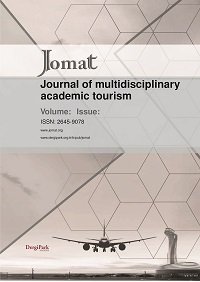The nature of tourism and tourists/pilgrims' inflow in Uttarakhand Himalaya
Nature of tourism, Tourists / pilgrims, Natural locales, Pilgrimages Uttarakhand Himalaya,
___
- Ellis, C. (2003) When volunteers pay to take a trip with scientists – Participatory Environmental Research Tourism (PERT), Hum. Dimen. Wildlife, 8(1), 75–80.
- Government of India, (2013) India Tourism Statistics at a Glance, Ministry of Tourism, Government of India, 2013; http://tourism.gov.in/sites/default/files/ Other/Incredible%20India%20final%2021-7-2014%20english.pdf (accessed on 1 May 2017).
- Kelman, I. and Dodds, R. (2009) Developing a code of ethics for disaster tourism. Int. J. Mass Emerg. Disasters, 27(3), 272–296.
- Kulendran, N. and Witt, S. F. (2003) Forecasting the demand for international business tourism. J. Travel Res., 41(3), 265–271.
- Sati, V. P. (2019) Himalaya on the Threshold of Change. Springer International Publishers, Switzerland, DOI 10.1007/978-3-030-14180-6, P. 250.
- Sati, V. P. (2018) Carrying Capacity Analysis and Destination Development: A Case Study of Gangotri Tourists/Pilgrims’ Circuit in the Himalaya, Asia Pacific Journal of Tourism Research APJTR Vol. 23 (3): 312-322, DOI: 10.1080/10941665.2018.1433220.
- Sati, V. P. (2015) Pilgrimage Tourism in Mountain Regions: Socio-Economic Implications in the Garhwal Himalaya, South Asian Journal of Tourism and Heritage, Vol 8(1) Pp: 164-182.
- Sati, V. P. (2013) Tourism Practices and Approaches for its Development in the Uttarakhand Himalaya, India, Journal of Tourism Challenges and Trends, Vol 6 (1), Pp. 97-112.
- Sharpley, R. (2004) Tourism: A Vehicle for Development? In R. Sharpley & D. J. Telfer (Eds.), Tourism and Development: Concepts and Issues: Channel View Publications.
- Smith, C. and Jenner, P. (1997) Educational tourism. Travel Tourism Anal., 3, 60–75.
- Tribe, J. (2009) Philosophical Issues in Tourism, Channel View Publications, Bristol, United Kingdom. World Tourism Organization (2005) Making Tourism More Sustainable: A Guide for Policy Makers, WTO Publications.
- WTTC (2015) Travel and Tourism economic impact 2015 Indonesia, The authority on World Travel and Tourism, World Travel and Tourism Council, on-line edition; rochelle.turner@wttc.org
- Yayın Aralığı: 3
- Başlangıç: 2016
- Yayıncı: Yusuf Karakuş
Md. ALAUDDİN, Syed Md. HASİB AHSAN, Md. AKTAR KAMAL, Mohammad MANJUR ALAM, Azizul HASSAN
The nature of tourism and tourists/pilgrims' inflow in Uttarakhand Himalaya
Thiago DUARTE PİMENTEL, Marcela Costa Bifano De OLİVEİRA, Fabíola Cristina Costa De CARVALHO, Eliza Feres DE LİMA MOURA
